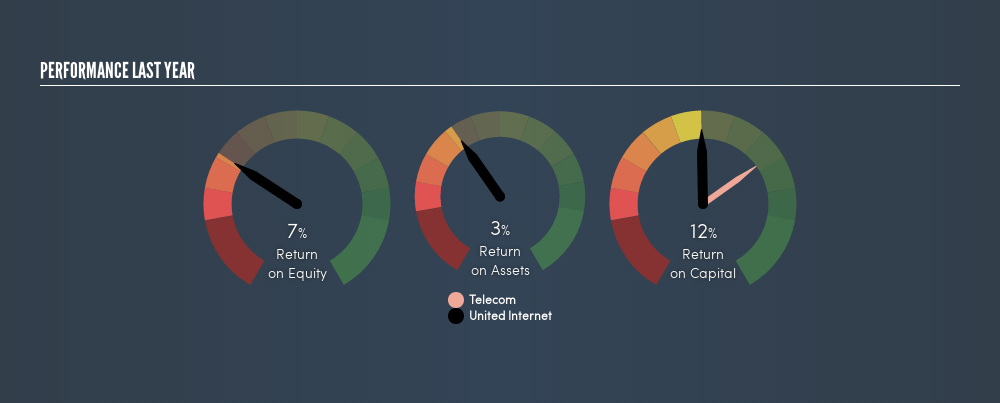- Germany
- /
- Telecom Services and Carriers
- /
- DB:UTDI
Why You Should Like United Internet AG’s (FRA:UTDI) ROCE

Want to participate in a short research study? Help shape the future of investing tools and you could win a $250 gift card!
Today we are going to look at United Internet AG (FRA:UTDI) to see whether it might be an attractive investment prospect. Specifically, we'll consider its Return On Capital Employed (ROCE), since that will give us an insight into how efficiently the business can generate profits from the capital it requires.
First of all, we'll work out how to calculate ROCE. Then we'll compare its ROCE to similar companies. Finally, we'll look at how its current liabilities affect its ROCE.
Understanding Return On Capital Employed (ROCE)
ROCE is a metric for evaluating how much pre-tax income (in percentage terms) a company earns on the capital invested in its business. In general, businesses with a higher ROCE are usually better quality. Ultimately, it is a useful but imperfect metric. Renowned investment researcher Michael Mauboussin has suggested that a high ROCE can indicate that 'one dollar invested in the company generates value of more than one dollar'.
So, How Do We Calculate ROCE?
The formula for calculating the return on capital employed is:
Return on Capital Employed = Earnings Before Interest and Tax (EBIT) ÷ (Total Assets - Current Liabilities)
Or for United Internet:
0.12 = €816m ÷ (€8.2b - €1.3b) (Based on the trailing twelve months to December 2018.)
Therefore, United Internet has an ROCE of 12%.
View our latest analysis for United Internet
Does United Internet Have A Good ROCE?
One way to assess ROCE is to compare similar companies. United Internet's ROCE appears to be substantially greater than the 8.5% average in the Telecom industry. We would consider this a positive, as it suggests it is using capital more effectively than other similar companies. Regardless of where United Internet sits next to its industry, its ROCE in absolute terms appears satisfactory, and this company could be worth a closer look.
As we can see, United Internet currently has an ROCE of 12%, less than the 19% it reported 3 years ago. Therefore we wonder if the company is facing new headwinds.

Remember that this metric is backwards looking - it shows what has happened in the past, and does not accurately predict the future. ROCE can be deceptive for cyclical businesses, as returns can look incredible in boom times, and terribly low in downturns. This is because ROCE only looks at one year, instead of considering returns across a whole cycle. Future performance is what matters, and you can see analyst predictions in our freereport on analyst forecasts for the company.
What Are Current Liabilities, And How Do They Affect United Internet's ROCE?
Current liabilities are short term bills and invoices that need to be paid in 12 months or less. The ROCE equation subtracts current liabilities from capital employed, so a company with a lot of current liabilities appears to have less capital employed, and a higher ROCE than otherwise. To check the impact of this, we calculate if a company has high current liabilities relative to its total assets.
United Internet has total liabilities of €1.3b and total assets of €8.2b. Therefore its current liabilities are equivalent to approximately 16% of its total assets. A fairly low level of current liabilities is not influencing the ROCE too much.
The Bottom Line On United Internet's ROCE
With that in mind, United Internet's ROCE appears pretty good. United Internet looks strong on this analysis, but there are plenty of other companies that could be a good opportunity . Here is a free list of companies growing earnings rapidly.
I will like United Internet better if I see some big insider buys. While we wait, check out this freelist of growing companies with considerable, recent, insider buying.
We aim to bring you long-term focused research analysis driven by fundamental data. Note that our analysis may not factor in the latest price-sensitive company announcements or qualitative material.
If you spot an error that warrants correction, please contact the editor at editorial-team@simplywallst.com. This article by Simply Wall St is general in nature. It does not constitute a recommendation to buy or sell any stock, and does not take account of your objectives, or your financial situation. Simply Wall St has no position in the stocks mentioned. Thank you for reading.
About DB:UTDI
United Internet
Through its subsidiaries, operates as an Internet service provider worldwide.
Undervalued with moderate growth potential.
Similar Companies
Market Insights
Community Narratives





